12.4E: Exercises for Section 12.4
- Last updated
- Jan 17, 2020
- Save as PDF
- Page ID
- 33360
( \newcommand{\kernel}{\mathrm{null}\,}\)
Determining Arc Length
In questions 1 - 5, find the arc length of the curve on the given interval.
1) ⇀r(t)=t2ˆi+(2t2+1)ˆj,1≤t≤3. This portion of the graph is shown here:

- Answer
- 8√5 units ≈17.9 units
2) ⇀r(t)=t2ˆi+14tˆj,0≤t≤7. This portion of the graph is shown here:
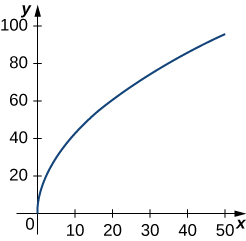
3) ⇀r(t)=⟨t2+1,4t3+3⟩,−1≤t≤0. This portion of the graph is shown here:
- Answer
- 154(373/2−1) units ≈4.15 units
4) \vecs r(t)=⟨2 \sin t,5t,2 \cos t⟩,\quad 0≤t≤π. This portion of the graph is shown here:
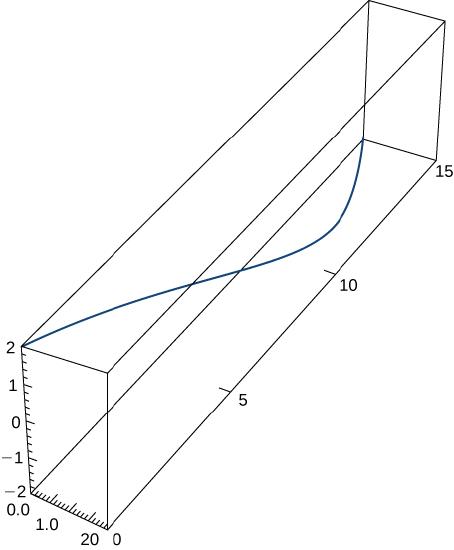
5) \vecs r(t)=⟨e^{−t \cos t},e^{−t \sin t}⟩ over the interval [0,\frac{π}{2}]. Here is the portion of the graph on the indicated interval:
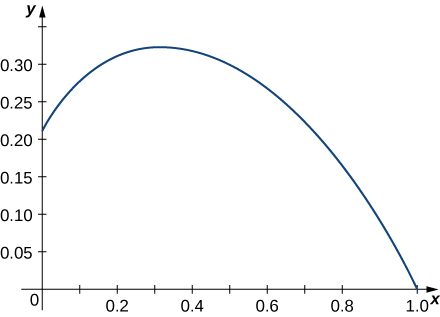
6) Set up an integral to represent the arc length from t = 0 to t = 2 along the curve traced out by \vecs r(t) = \langle t, \, t^4\rangle. Then use technology to approximate this length to the nearest thousandth of a unit.
7) Find the length of one turn of the helix given by \vecs r(t)= \frac{1}{2} \cos t \,\hat{\mathbf{i}}+\frac{1}{2} \sin t \,\hat{\mathbf{j}}+\frac{\sqrt{3}}{2}\,t \,\hat{\mathbf{k}}.
- Answer
- Length =2π units
8) Find the arc length of the vector-valued function \vecs r(t)=−t \,\hat{\mathbf{i}}+4t \,\hat{\mathbf{j}}+3t \,\hat{\mathbf{k}} over [0,1].
9) A particle travels in a circle with the equation of motion \vecs r(t)=3 \cos t \,\hat{\mathbf{i}}+3 \sin t \,\hat{\mathbf{j}} +0 \,\hat{\mathbf{k}}. Find the distance traveled around the circle by the particle.
- Answer
- 6π units
10) Set up an integral to find the circumference of the ellipse with the equation \vecs r(t)= \cos t \,\hat{\mathbf{i}}+2 \sin t \,\hat{\mathbf{j}}+0\,\hat{\mathbf{k}}.
11) Find the length of the curve \vecs r(t)=⟨\sqrt{2}t,\, e^t, \, e^{−t}⟩ over the interval 0≤t≤1. The graph is shown here:
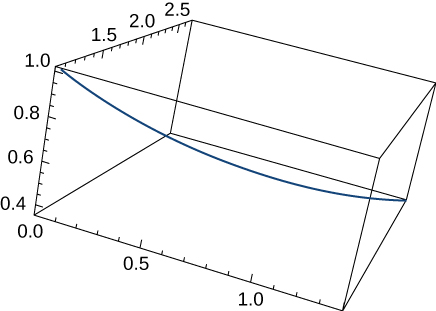
- Answer
- \left(e−\frac{1}{e}\right) units \approx 2.35 units
12) Find the length of the curve \vecs r(t)=⟨2 \sin t, \, 5t, \, 2 \cos t⟩ for t∈[−10,10].
Unit Tangent Vectors and Unit Normal Vectors
13) The position function for a particle is \vecs r(t)=a \cos( ωt) \,\hat{\mathbf{i}}+b \sin (ωt) \,\hat{\mathbf{j}}. Find the unit tangent vector and the unit normal vector at t=0.
- Solution:
- \begin{align*} \vecs r'(t) &= -aω \sin( ωt) \,\hat{\mathbf{i}}+bω \cos (ωt) \,\hat{\mathbf{j}}\\[5pt]
\| \vecs r'(t) \| &= \sqrt{a^2 ω^2 \sin^2(ωt) +b^2ω^2\cos^2(ωt)} \\[5pt]
\vecs T(t) &= \dfrac{\vecs r'(t)}{\| \vecs r'(t) \| } = \dfrac{-aω \sin( ωt) \,\hat{\mathbf{i}}+bω \cos (ωt) \,\hat{\mathbf{j}}}{\sqrt{a^2 ω^2 \sin^2(ωt) +b^2ω^2\cos^2(ωt)}}\\[5pt]
\vecs T(0) &= \dfrac{bω \,\hat{\mathbf{j}}}{\sqrt{(bω)^2}} = \dfrac{bω \,\hat{\mathbf{j}}}{|bω|}\end{align*}
If bω > 0, \; \vecs T(0) = \hat{\mathbf{j}}, and if bω < 0, \; T(0)= -\hat{\mathbf{j}}
- Answer
- If bω > 0, \; \vecs T(0)= \hat{\mathbf{j}}, and if bω < 0, \; \vecs T(0)= -\hat{\mathbf{j}}
If a > 0, \; \vecs N(0)= -\hat{\mathbf{i}}, and if a < 0, \; \vecs N(0)= \hat{\mathbf{i}}
14) Given \vecs r(t)=a \cos (ωt) \,\hat{\mathbf{i}} +b \sin (ωt) \,\hat{\mathbf{j}}, find the binormal vector \vecs B(0).
15) Given \vecs r(t)=⟨2e^t,e^t \cos t,e^t \sin t⟩, determine the unit tangent vector \vecs T(t).
- Answer
- \begin{align*} \vecs T(t) &=\left\langle \frac{2}{\sqrt{6}},\, \frac{\cos t− \sin t}{\sqrt{6}}, \, \frac{\cos t+ \sin t}{\sqrt{6}}\right\rangle \\[4pt] &= \left\langle\frac{\sqrt{6}}{3},\, \frac{\sqrt{6}}{6} (\cos t− \sin t), \, \frac{\sqrt{6}}{6} (\cos t+ \sin t)\right\rangle \end{align*}
16) Given \vecs r(t)=⟨2e^t,\, e^t \cos t,\, e^t \sin t⟩, find the unit tangent vector \vecs T(t) evaluated at t=0, \vecs T(0).
17) Given \vecs r(t)=⟨2e^t,\, e^t \cos t,\, e^t \sin t⟩, determine the unit normal vector \vecs N(t).
- Answer
- \vecs N(t)=⟨0,\, -\frac{\sqrt{2}}{2} (\sin t + \cos t), \, \frac{\sqrt{2}}{2} (\cos t- \sin t)⟩
18) Given \vecs r(t)=⟨2e^t,\, e^t \cos t,\, e^t \sin t⟩, find the unit normal vector \vecs N(t) evaluated at t=0, \vecs N(0).
- Answer
- \vecs N(0)=⟨0, \;-\frac{\sqrt{2}}{2},\;\frac{\sqrt{2}}{2}⟩
19) Given \vecs r(t)=t \,\hat{\mathbf{i}}+t^2 \,\hat{\mathbf{j}}+t \,\hat{\mathbf{k}}, find the unit tangent vector \vecs T(t). The graph is shown here:
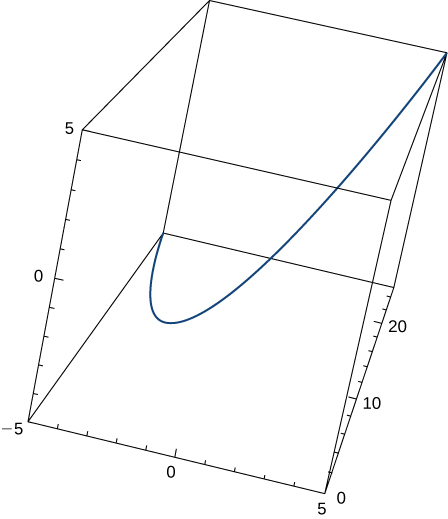
- Answer
- \vecs T(t)=\dfrac{1}{\sqrt{4t^2+2}}<1,2t,1>
20) Find the unit tangent vector \vecs T(t) and unit normal vector \vecs N(t) at t=0 for the plane curve \vecs r(t)=⟨t^3−4t,5t^2−2⟩. The graph is shown here:
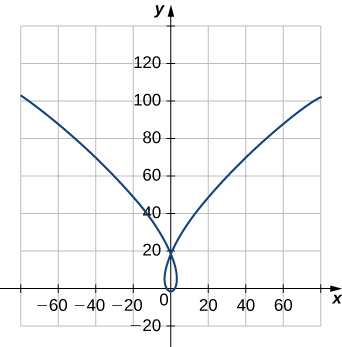
21) Find the unit tangent vector \vecs T(t) for \vecs r(t)=3t \,\hat{\mathbf{i}}+5t^2 \,\hat{\mathbf{j}}+2t \,\hat{\mathbf{k}}.
- Answer
- \vecs T(t)=\dfrac{1}{\sqrt{100t^2+13}}(3 \,\hat{\mathbf{i}}+10t \,\hat{\mathbf{j}}+2 \,\hat{\mathbf{k}})
22) Find the principal normal vector to the curve \vecs r(t)=⟨6 \cos t,6 \sin t⟩ at the point determined by t=\frac{π}{3}.
23) Find \vecs T(t) for the curve \vecs r(t)=(t^3−4t) \,\hat{\mathbf{i}}+(5t^2−2) \,\hat{\mathbf{j}}.
- Answer
- \vecs T(t)=\dfrac{1}{\sqrt{9t^4+76t^2+16}}\big((3t^2−4)\,\hat{\mathbf{i}}+10t \,\hat{\mathbf{j}}\big)
24) Find \vecs N(t) for the curve \vecs r(t)=(t^3−4t)\,\hat{\mathbf{i}}+(5t^2−2)\,\hat{\mathbf{j}}.
25) Find the unit tangent vector \vecs T(t) for \vecs r(t)=⟨2 \sin t,\, 5t,\, 2 \cos t⟩.
- Answer
- \vecs T(t)=⟨\frac{2\sqrt{29}}{29}\cos t,\, \frac{5\sqrt{29}}{29},\,−\frac{2\sqrt{29}}{29}\sin t⟩
26) Find the unit normal vector \vecs N(t) for \vecs r(t)=⟨2\sin t,\,5t,\,2\cos t⟩.
- Answer
- \vecs N(t)=⟨−\sin t,\, 0,\, −\cos t⟩
Arc Length Parameterizations
27) Find the arc-length function \vecs s(t) for the line segment given by \vecs r(t)=⟨3−3t,\, 4t⟩. Then write the arc-length parameterization of r with s as the parameter.
- Answer
- Arc-length function: s(t)=5t; The arc-length parameterization of \vecs r(t): \vecs r(s)=\left(3−\dfrac{3s}{5}\right)\,\hat{\mathbf{i}}+\dfrac{4s}{5}\,\hat{\mathbf{j}}
28) Parameterize the helix \vecs r(t)= \cos t \,\hat{\mathbf{i}}+ \sin t \,\hat{\mathbf{j}}+t \,\hat{\mathbf{k}} using the arc-length parameter s, from t=0.
29) Parameterize the curve using the arc-length parameter s, at the point at which t=0 for \vecs r(t)=e^t \sin t \,\hat{\mathbf{i}} + e^t \cos t \,\hat{\mathbf{j}}
- Answer
- \vecs r(s)=\left(1+\dfrac{s}{\sqrt{2}}\right) \sin \left( \ln \left(1+ \dfrac{s}{\sqrt{2}}\right)\right)\,\hat{\mathbf{i}} +\left(1+ \dfrac{s}{\sqrt{2}}\right) \cos \left( \ln \left(1+\dfrac{s}{\sqrt{2}}\right)\right)\,\hat{\mathbf{j}}
Curvature and the Osculating Circle
30) Find the curvature of the curve \vecs r(t)=5 \cos t \,\hat{\mathbf{i}}+4 \sin t \,\hat{\mathbf{j}} at t=π/3. (Note: The graph is an ellipse.)
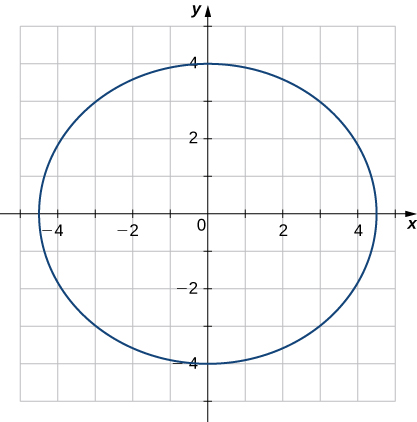
31) Find the x-coordinate at which the curvature of the curve y=1/x is a maximum value.
- Answer
- The maximum value of the curvature occurs at x=1.
32) Find the curvature of the curve \vecs r(t)=5 \cos t \,\hat{\mathbf{i}}+5 \sin t \,\hat{\mathbf{j}}. Does the curvature depend upon the parameter t?
33) Find the curvature κ for the curve y=x−\frac{1}{4}x^2 at the point x=2.
- Answer
- \frac{1}{2}
34) Find the curvature κ for the curve y=\frac{1}{3}x^3 at the point x=1.
35) Find the curvature κ of the curve \vecs r(t)=t \,\hat{\mathbf{i}}+6t^2 \,\hat{\mathbf{j}}+4t \,\hat{\mathbf{k}}. The graph is shown here:
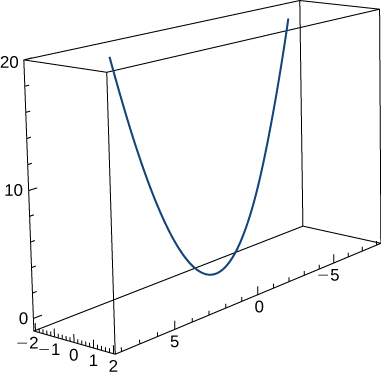
- Answer
- κ≈\dfrac{49.477}{(17+144t^2)^{3/2}}
36) Find the curvature of \vecs r(t)=⟨2 \sin t,5t,2 \cos t⟩.
37) Find the curvature of \vecs r(t)=\sqrt{2}t \,\hat{\mathbf{i}}+e^t \,\hat{\mathbf{j}}+e^{−t} \,\hat{\mathbf{k}} at point P(0,1,1).
- Answer
- \frac{1}{2\sqrt{2}}
38) At what point does the curve y=e^x have maximum curvature?
39) What happens to the curvature as x→∞ for the curve y=e^x?
- Answer
- The curvature approaches zero.
40) Find the point of maximum curvature on the curve y=\ln x.
41) Find the equations of the normal plane and the osculating plane of the curve \vecs r(t)=⟨2 \sin (3t),t,2 \cos (3t)⟩ at point (0,π,−2).
- Answer
- y=6x+π and x+6y=6π
42) Find equations of the osculating circles of the ellipse 4y^2+9x^2=36 at the points (2,0) and (0,3).
43) Find the equation for the osculating plane at point t=π/4 on the curve \vecs r(t)=\cos (2t) \,\hat{\mathbf{i}}+ \sin (2t) \,\hat{\mathbf{j}}+t\,\hat{\mathbf{k}}.
- Answer
- x+2z=\frac{π}{2}
44) Find the radius of curvature of 6y=x^3 at the point (2,\frac{4}{3}).
45) Find the curvature at each point (x,y) on the hyperbola \vecs r(t)=⟨a \cosh( t),b \sinh (t)⟩.
- Answer
- \dfrac{a^4b^4}{(b^4x^2+a^4y^2)^{3/2}}
46) Calculate the curvature of the circular helix \vecs r(t)=r \sin (t) \,\hat{\mathbf{i}}+r \cos (t) \,\hat{\mathbf{j}}+t \,\hat{\mathbf{k}}.
47) Find the radius of curvature of y= \ln (x+1) at point (2,\ln 3).
- Answer
- \frac{10\sqrt{10}}{3}
48) Find the radius of curvature of the hyperbola xy=1 at point (1,1).
A particle moves along the plane curve C described by \vecs r(t)=t \,\hat{\mathbf{i}}+t^2 \,\hat{\mathbf{j}}. Use this parameterization to answer questions 49 - 51.
49) Find the length of the curve over the interval [0,2].
- Answer
- \frac{1}{4}\big[ 4\sqrt{17} + \ln\left(4+\sqrt{17}\right)\big]\text{ units }\approx 4.64678 \text{ units}
50) Find the curvature of the plane curve at t=0,1,2.
51) Describe the curvature as t increases from t=0 to t=2.
- Answer
- The curvature is decreasing over this interval.
The surface of a large cup is formed by revolving the graph of the function y=0.25x^{1.6} from x=0 to x=5 about the y-axis (measured in centimeters).
52) [T] Use technology to graph the surface.
53) Find the curvature κ of the generating curve as a function of x.
- Answer
- κ=\dfrac{30}{x^{2/5}\left(25+4x^{6/5}\right)^{3/2}}
Note that initially your answer may be:
\dfrac{6}{25x^{2/5}\left(1+\frac{4}{25}x^{6/5}\right)^{3/2}}
We can simplify it as follows:
\begin{align*} \dfrac{6}{25x^{2/5}\left(1+\frac{4}{25}x^{6/5}\right)^{3/2}} &= \dfrac{6}{25x^{2/5}\big[\frac{1}{25}\left(25+4x^{6/5}\right)\big]^{3/2}}\\[4pt] &= \dfrac{6}{25x^{2/5}\left(\frac{1}{25}\right)^{3/2}\big[25+4x^{6/5}\big]^{3/2}} \\[4pt] &= \dfrac{6}{\frac{25}{125}x^{2/5}\big[25+4x^{6/5}\big]^{3/2}} \\[4pt] &= \dfrac{30}{x^{2/5}\left(25+4x^{6/5}\right)^{3/2}}\end{align*}
54) [T] Use technology to graph the curvature function.
Contributors:
Gilbert Strang (MIT) and Edwin “Jed” Herman (Harvey Mudd) with many contributing authors. This content by OpenStax is licensed with a CC-BY-SA-NC 4.0 license. Download for free at http://cnx.org.
- Paul Seeburger (Monroe Community College) created question 6.


